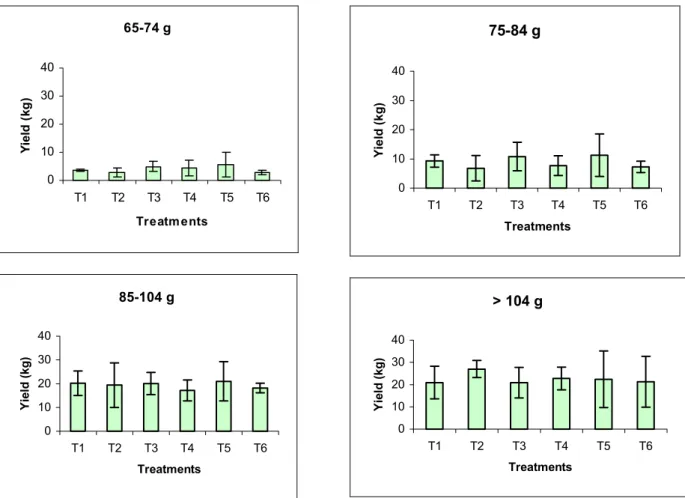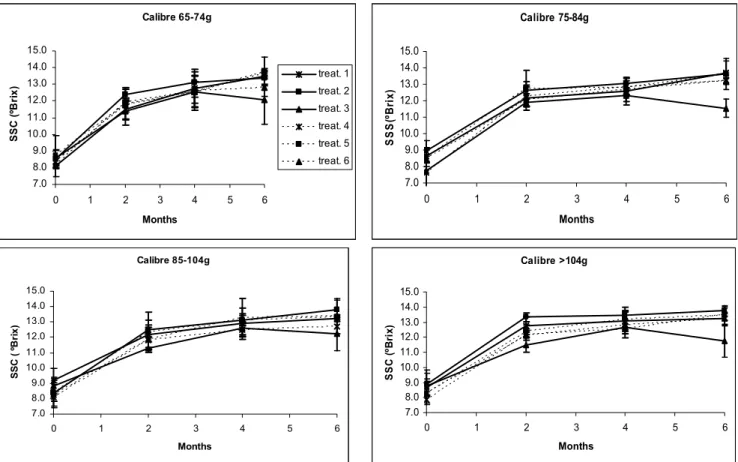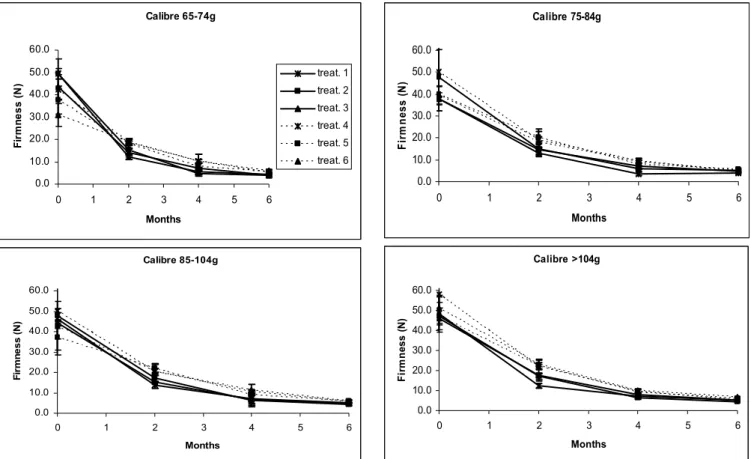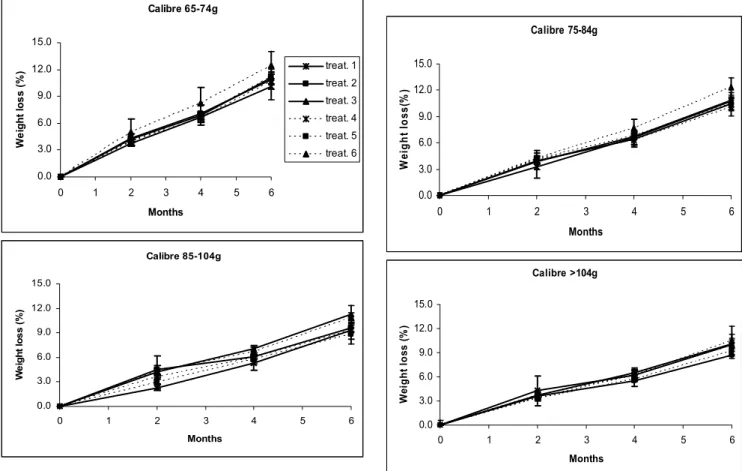The effect of pre and postharvest calcium applications on ‘Hayward’
kiwifruit storage ability
ANTUNESa1, M.D.C., N. NEVESb, F. CURADOb, S. RODRIGUESc, T. PANAGOPOULOSa
aUniversidade do Algarve, F.E.R.N., Campus de Gambelas, 8000 Faro, Portugal bDirecção Regional de Agricultura da Beira Litoral,3000 Coimbra, Portugal cKIWICOOP-Cooperativa frutícola da Bairrada, 3770 Oliveira do Bairro, Portugal
1Corresponding author. Tel.: +351 289800930; Fax: +351 289818419; e-mail: mantunes@ualg.pt
Abstract
The benefits of calcium applications pre and postharvest on fruit storage ability have been mentioned in the bibliography. It was objective of this work to study the effect of calcium preharvest application in two different forms and calcium chloride application postharvest on ‘Hayward’ kiwifruit storage ability.
Kiwifruit vines were sprayed with 0.03% CaCl2 or 0.03% CaO at one, three and four months before harvest. The control did not have any treatment. After harvest, half fruits were dipped for 2 min in a solution of 1% CaCl2, left to dry and stored at 0ºC. The other half was stored at the same temperature without any treatment.
The commercial yield was not affected by treatments. During storage, fruits dipped in 1% CaCl2 softened slower and than fruits not treated. Weight loss was higher in fruits treated with CaO preharvest. SSC showed a significant decrease in fruits sprayed with CaO from 4 to 6 months storage.
This work suggests that immersion of kiwifruit in 1% CaCl2 postharvest benefits storage life capacity; preharvest spaying with CaCl2 seems to be better than with CaO. However, we have to try higher calcium concentrations in order to get better results in storage ability but, without causing toxicity on the vines.
Key words: kiwifruit, calcium, postharvest, preharvest, firmness. 1. Introduction
Kiwifruit can be air-stored for 4 to 6 months at 0oC, although extensive softening will occur (Antunes and Sfakiotakis, 2002). Removal of ethylene from storage rooms is important. Freshly harvested kiwifruit soften rapidly to around 20N during the first 2 months at 0ºC, after which they soften slowly (Antunes and Sfakiotakis, 1997). According to the same authors the soluble solids content (SSC) has a similar pattern. However, rates of softening vary significantly among cultivars or regions, with some fruits commencing softening earlier than others (Xie and Jiang, 1994). Retaining and controlling postharvest kiwifruit ripening is of a great commercial importance to be able to feed continuously the market.
The pre and postharvest application of calcium salts has been used successfully in many fresh fruits to reduce loss of firmness and to slow down the ripening process (Souty et al., 1995). Calcium alters intracellular and extracellular processes which retard ripening exemplified by lower rates of colour change, softening, CO2 and ethylene production, increase in sugar, and a reduction in total acid content (Conway,
The objective of the present work was to study the effect of calcium preharvest application in two different forms (CaCl2 and CaO) and CaCl2 application postharvest on the quality preservation of ‘Hayward’ kiwifruit during storage.
2. Material and methods
2.1. Plant material and treatments
Kiwifruit vines (cv. Hayward) grown in an orchard in Beira Litoral, Portugal were sprayed with 0.03% CaCl2 (Antistip) or 0.03% CaO (Chelal) at one, three and four months before harvest. The control did not have any treatment.
Fruits were harvested at the beginning of November and immediately transferred to a storage room at 0ºC. After one week, fruits free of defects were selected and separated according to predetermined calibres: 65-74, 75-84, 85-104 and >104g. Then, half fruits from each calibre were dipped for 2 min in a solution of 1% CaCl2, left to dry and stored at 0ºC. The other half was stored at the same temperature without any treatment.
Treatments were identified as follow: Treatment 1 = control (no Ca spraying); Treatment 2 = kiwifruit sprayed with 0.03% CaCl2; Treatment 3 = kiwifruit sprayed with 0.03% CaO; Treatment 4 = Kiwifruit without any Ca spraying + dipping in 1% CaCl2 postharvest; Treatment 5 = Kiwifruit sprayed with 0.03% CaCl2 + dipping in 1% CaCl2 postharvest; Treatment 6 = Kiwifruit sprayed with 0.03% CaO + dipping in 1% CaCl2 postharvest.
Ten fruits per replication were removed from storage at intervals of 0, 2, 4, and 6 months, for measurements of flesh firmness, SSC and weight loss.
Statistical analyses were made with a SPSS computer program. Two-way analyses of variance (ANOVA) and Duncan’s Multiple-Range Tests (P<0.05) for comparisons between treatments over time were conducted.
2.2. Soluble solids content (SSC), firmness and weight loss
Flesh firmness was recorded by puncture with a Chatillon penetrometer (John Chatillon & Sons, Inc. U.S.A) fitted with a flat-8mm diameter tip. The tip was inserted after skin removal, at the fruit equator, in opposite sides, to a depth of 7mm. The SSC were measured using a digital Atago refractometer (model PR1-Atago Co. LTD, Japan) in juice from the equatorial zone of the fruit. Weight loss was calculated as a percentage of the initial fruit weight.
3. Results
3.1. Kiwifruit Yield
There were no significant differences among treatments in marketable or total yield in any calibre (Figure 1). Yield was significantly higher for fruits of > 104g without significant differences with fruits of 85-104 g, followed by 75-84 and 65-74 g.
3.2. Soluble solids content (SSC)
The SSC increased mostly in the first 2 months storage, and remained almost constant thereafter for all treatments (Figure 2).
Kiwifruit did not show significant differences in SSC among treatments till 4 months storage for all calibres.
Fruits sprayed with CaO showed for all calibres slightly lower SSC. At the end of the storage period, a significant decrease in SSC from fruits sprayed with CaO was observed for all calibres.
3.3. Flesh firmness
Kiwifruit of all calibres behaved similarly in terms of softening through the storage period (Figure 3). Fruit of control had a great decrease in firmness till 2 months storage and slower thereafter.
Fruits sprayed with CaCl2 or CaO had a similar behaviour but showed significant softening from 2 to 4 months storage. Kiwifruit dipped in 1% CaCl2 softened slower through time, although at the end of the storage period all fruit were equally soft.
3.4. Weight loss
Weight loss increased through storage for all treatments and calibres (Figure 4). Till 2 months storage there was no significant differences in weight loss between treatments.
Weight loss was higher in fruits treated with CaO preharvest after 4 and 6 months storage. This behaviour was in all calibres except calibre >104mm. In this last calibre we found no significant differences in weigh loss among treatments.
4. Discussion
It is known that calcium ions make bridges between peptic molecules in the middle lamella being responsible for cell cohesion (Knee and Bartley, 1981). So, softening can be the result of the loss of calcium from the middle lamella and/or a loss of its place in the connections between the peptic molecules (Knee, 1982). Calcium infiltrations pre and postharvest in fruit tissues, delays softening rate and ripening, by retarding the loss of disintegration of cell walls (Roy et al., 1994).
The commercial yield was not affected by treatments. Also we found not important differences in ripening parameters between kiwifruit calibres.
‘Hayward’ kiwifruit showed a great decrease in firmness and increase in SSC in the first two months at 0ºC as previously reported (Antunes and Sfakiotakis, 1997). Fruits sprayed on the vine either with 0.03% CaO or 0.03% CaCl2, were slightly more firm than control fruits. Gerasopoulos et al. (1996) found higher firmness through storage in fruits sprayed three times on the vine with 0.375% CaCl2. However, it was our aim to try the smallest recommended manufacturer concentrations for Checal and Antistip, to see their effect on kiwifruit keeping quality through storage.
During storage, fruits dipped in 1% CaCl2 softened slower than fruits not treated. Mainly, they reduce the effect of the rapid softening and of kiwifruit during the first storage months as did previously controlled atmosphere storages ((Antunes and Sfakiotakis, 1997).
Weight loss was higher in kiwifruit treated with CaO preharvest than in the other treatments. Also, those fruits had a decrease in SSC from 4 to 6 month storage, indicating a faster senescence process.
This work suggests that immersion of kiwifruit in 1% CaCl2 postharvest benefits storage life capacity; preharvest spaying with CaCl2 seems to be better than with CaO. However, we have to try higher calcium concentrations in order to get better results in storage ability but, without causing toxicity on the vines.
Acknowledgements
This work was supported by Project ‘Regularidade produtiva, qualidade e conservação dos frutos de actinídea nas regiões de Entre-Douro e Minho e Beira Litoral’, Programa Agro/medida 8.1/ nº 231.
References
Antunes, M. D. C., Sfakiotakis, E. M., 1997. The effect of controlled atmosphere and ultra low oxygen on storage ability and quality of ‘Hayward’ kiwifruit. Acta Hort. 444, 613-618.
Antunes, M. D. C. and E. M Sfakiotakis. 2002. Ethylene biosynthesis and ripening behaviour of 'Hayward' kiwifruit subjected to some controlled atmospheres. Post.
Biol. Technol. 26: 167-179.
Antunes, M. D. C., Pateraki, I., Kanellis, A. K., Sfakiotakis, E. M., 2000. Differential effects of low temperature inhibition on the propylene induced autocatalysis of ethylene production, respiration and ripening of ‘Hayward’ kiwifruit. J. Hort. Sci. & Biotechnol. 75 (5), 575-580.
Conway, W. S. 1987. The effects of postharvest infiltration of calcium, magnesium or strontium on decay, firmness, respiration and ethylene production in apples. J. Am. Soc. Hortic. Sci. 112(2): 300-303.
Gerasopoulos, D., Chouliaras, V. and Lionakis, S. 1996. Effects of preharvest calcium chloride sprays on maturity and storability of Hayward kiwifruit. Post. Biol.
Technol. 7: 65-72.
Knee, M. 1982. Fruit softening. III. Requirement for oxygen and pH effects. J. Exp. Bot. 33: 1263-1269.
Knee, M.; Bartley, I. M. 1981. Composition and metabolism of cell wall polysaccharides in ripening fruits. In: J. Friends and M.J.C. Rhodes (editors). Recent advances in the biochemistry of fruits and vegetables. Academic Press. London and New York. Pp 133-148.
Link, H. 1974. Ca-uptake and translocation by plants with special regard to apple trees. Acta Hort. 45: 53-64.
Roy, S.; Conway, W.S.; Watada, A.E.; Sams, C.E.; Pooley, C.D. ; Werning, W.P. 1994. Distribution of the anionic sites in the cell wall of apple fruit after calcium treatment. Quantification and visualization by a cationic colloidal gold probe. Protoplasma. 178: 156-167.
Souty, M.; Reich, M.; Breuils, L.; Chambroy, Y.; Jacquemin, G.; Audergon, J. M. 1995. Effects of Postharvest Calcium Treatments on Shelf-life and Quality of Apricot Fruit. Acta
Horticulturae. 384: 619-623.
Xie, M., and Jiang, G.H. 1994. Relationship of the physiological changes during postharvest ripening to the storage quality of kiwifruit. Acta Agric. Zhej. 64(3): 124-127.
65-74 g 0 10 20 30 40 T1 T2 T3 T4 T5 T6 Treatments Y ie ld (k g) 85-104 g 0 10 20 30 40 T1 T2 T3 T4 T5 T6 Treatments Y iel d (kg) 75-84 g 0 10 20 30 40 T1 T2 T3 T4 T5 T6 Treatments Yie ld ( k g) > 104 g 0 10 20 30 40 T1 T2 T3 T4 T5 T6 Treatments Y iel d ( kg)
Figure 1. Total yield per vine of kiwifruit subjected to the treatments: T1 and T4 = control (no Ca spraying); T2 and T5 = kiwifruit sprayed with 0.03% CaCl2; T3 and T6 = kiwifruit sprayed with 0.03% CaO.
Calibre 65-74g 7.0 8.0 9.0 10.0 11.0 12.0 13.0 14.0 15.0 0 1 2 3 4 5 6 Months S S C ( ºBr ix ) treat. 1 treat. 2 treat. 3 treat. 4 treat. 5 treat. 6 Calibre 85-104g 7.0 8.0 9.0 10.0 11.0 12.0 13.0 14.0 15.0 0 1 2 3 4 5 6 Months SS C ( ºB ri x ) Calibre 75-84g 7.0 8.0 9.0 10.0 11.0 12.0 13.0 14.0 15.0 0 1 2 3 4 5 6 Months SS S( ºB ri x) Calibre >104g 7.0 8.0 9.0 10.0 11.0 12.0 13.0 14.0 15.0 0 1 2 3 4 5 6 Months SSC ( ºB ri x)
Figure 2. Soluble solids content of ‘Hayward’ kiwifruit during storage at 0ºC, subjected to the treatments: Treat. 1 = control (no Ca spraying); Treat. 2 = kiwifruit sprayed with 0.03% CaCl2; Treat. 3 = kiwifruit sprayed with 0.03% CaO; Treat. 4 = Kiwifruit without any Ca spraying + dipping in 1% CaCl2 postharvest; Treat. 5 = Kiwifruit sprayed with 0.03% CaCl2 + dipping in 1% CaCl2 postharvest; Treat. 6 = Kiwifruit sprayed with 0.03% CaO + dipping in 1% CaCl2 postharvest.
Calibre 65-74g 0.0 10.0 20.0 30.0 40.0 50.0 60.0 0 1 2 3 4 5 6 Months F irm n ess ( N ) treat. 1 treat. 2 treat. 3 treat. 4 treat. 5 treat. 6 Calibre 85-104g 0.0 10.0 20.0 30.0 40.0 50.0 60.0 0 1 2 3 4 5 6 Months Fi rm ne s s ( N ) Calibre 75-84g 0.0 10.0 20.0 30.0 40.0 50.0 60.0 0 1 2 3 4 5 6 Months Fi rm ne ss ( N ) Calibre >104g 0.0 10.0 20.0 30.0 40.0 50.0 60.0 0 1 2 3 4 5 6 Months Fi rm n es s ( N )
Figure 3. Firmness of ‘Hayward’ kiwifruit during storage at 0ºC, subjected to the treatments: Treat. 1 = control (no Ca spraying); Treat. 2 = kiwifruit sprayed with 0.03% CaCl2; Treat. 3 = kiwifruit sprayed with 0.03% CaO; Treat. 4 = Kiwifruit without any Ca spraying + dipping in 1% CaCl2 postharvest; Treat. 5 = Kiwifruit sprayed with 0.03% CaCl2 + dipping in 1% CaCl2 postharvest; Treat. 6 = Kiwifruit sprayed with 0.03% CaO + dipping in 1% CaCl2 postharvest.
Calibre 65-74g 0.0 3.0 6.0 9.0 12.0 15.0 0 1 2 3 4 5 6 Months W e ig h t lo s s ( % ) treat. 1 treat. 2 treat. 3 treat. 4 treat. 5 treat. 6 Calibre 85-104g 0.0 3.0 6.0 9.0 12.0 15.0 0 1 2 3 4 5 6 Months W e ig h t lo s s ( % ) Calibre 75-84g 0.0 3.0 6.0 9.0 12.0 15.0 0 1 2 3 4 5 6 Months W ei ght l o ss (% ) Calibre >104g 0.0 3.0 6.0 9.0 12.0 15.0 0 1 2 3 4 5 6 Months W eigh t l o ss ( % )
Figure 4. Weight loss of ‘Hayward’ kiwifruit during storage at 0ºC, subjected to the treatments: Treat. 1 = control (no Ca spraying); Treat. 2 = kiwifruit sprayed with 0.03% CaCl2; Treat. 3 = kiwifruit sprayed with 0.03% CaO; Treat. 4 = Kiwifruit without any Ca spraying + dipping in 1% CaCl2 postharvest; Treat. 5 = Kiwifruit sprayed with 0.03% CaCl2 + dipping in 1% CaCl2 postharvest; Treat. 6 = Kiwifruit sprayed with 0.03% CaO + dipping in 1% CaCl2 postharvest.



